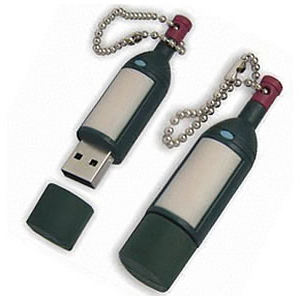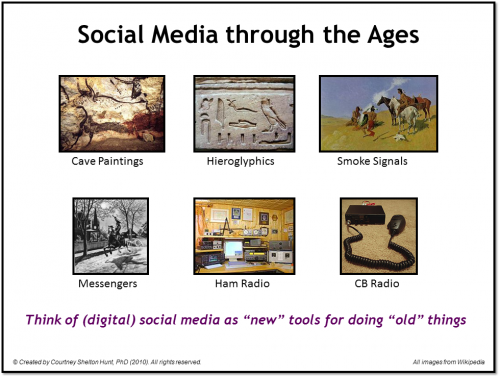 Summary: We often refer to social media as “new tools for doing old things.” In fact, it was the tagline for The Denovati Group’s predecessor, Social Media in Organizations (SMinOrgs). Like many simply stated ideas, it can be subject to (mis)interpretation, including equating the idea with “old wine in new bottles.” This post explains the concept’s genesis and meaning, in terms of both its original intent and beyond. (from the Denovati SMART Blog)
Summary: We often refer to social media as “new tools for doing old things.” In fact, it was the tagline for The Denovati Group’s predecessor, Social Media in Organizations (SMinOrgs). Like many simply stated ideas, it can be subject to (mis)interpretation, including equating the idea with “old wine in new bottles.” This post explains the concept’s genesis and meaning, in terms of both its original intent and beyond. (from the Denovati SMART Blog)
This is an updated version of a classic SMinOrgs S.M.A.R.T. Blog post from January 2011. As with all of the posts we’ve elected to transfer to the new blog, its ideas are still valid today.
Why “New Tools for Doing Old Things” is not “Old Wine in New Bottles”
I began referring to social media as “new tools for doing old things” in late 2009, and I liked the idea so much I made it the tagline for The Denovati Group’s predecessor, Social Media in Organizations (SMinOrgs).
Not everyone shared my enthusiasm for the concept, however. After visiting the SMinOrgs website in late 2010, Luc de Ruijter posted the following:
I just clicked to the linked site Courtney. What do I read at the top of the page? “New Tools for doing Old Things”(!) I think this is missing the point. We’re going through fundamental changes in our ways of communicating. The innovative web is hardly a new media bottle for old persuasive wine. Or is it?
Though it could have been interpreted as reflecting his professional bias and/or a cynical perspective, Luc’s question was understandable – and certainly worthy of a response. Since other folks could be similarly dubious – or perhaps just unclear – I decided it was worthwhile to explain the genesis and meaning of the tagline, in terms of both its original intent and beyond.
Unlike other social media resources, the SMinOrgs Community was targeted to rookies – and in some respects, even to doubters and non-believers. In spite of all the media hype and enthusiasm of early adopters, the vast majority of people had barely begun to climb their social media learning curves and think about how they could leverage new digital technologies in a professional context, both individually and within their organizations (note: this is still true today, over four years later).
Though fewer people today consider social media a fad than they did when SMinOrgs was founded in 2009, there is still a great deal of apprehension and confusion. I initially addressed those concerns in Part 1 of the Social Media Primer by defining social media technologies and putting them in historical context to demonstrate that although they seem revolutionary, they are a natural extension of the efforts we’ve made for millennia to find better ways to communicate, collaborate, and connect with one another, as well as to achieve our goals and objectives. To further reinforce those points, I provided additional historical examples of social media in the update to Parts 1 and 2 of the Primer.
It is true, as Luc noted, that “we’re going through fundamental changes in our ways of communicating.” But I would argue that rather than simply finding new ways of communicating, 2.0 technologies enable us to return to old ways that are more user-driven, egalitarian, and participatory. In other words, the means of communication we’ve experienced since the Industrial Revolution matured and big government, big business, and big media became predominant may be the more likely historical anomaly. In the latter part of the twentieth century in particular, a model evolved where the powers that be talked at us, rather than with us, and many folks not in power (grudgingly) accepted their passive role. With the advent of the internet, however, things started to shift, and people became increasingly empowered to find their voices again.
We can certainly see the results of that empowerment in people’s personal lives, through the popularity of platforms like Facebook and YouTube and increased user-generated activity on blogs and digital news stories. We can also see evidence of the power shift in consumer-oriented businesses that leverage sites like Facebook and Twitter to transform their marketing, sales, public relations, and customer service activities to be more engaging and interactive. But as I discuss in Part 2 of the Primer, transforming external applications is just the tip of the iceberg. As both individual contributors and organizational leaders become more comfortable with social media and recognize its potential benefits, the underlying technologies will become increasingly invaluable in helping them pursue their goals and objectives. This is another example of what I mean by “new tools for doing old things” – the idea that social technologies don’t change overarching goals and objectives (i.e., increasing revenue, decreasing expenses, enhancing collaboration, improving communication), but they do provide new – and potentially more effective – ways of achieving them.
Thinking of social technologies as “a new media bottle for old persuasive wine,” as Luc asserts, reflects a 1.0 approach to communication; that is, it presumes these technologies will be used for talking at rather than talking with, and that the communication is strictly one way, from a person/organization in power to an audience of the relatively powerless. Many 2.0 purists would say that’s completely inappropriate, but there’s nothing inherently wrong with it. Persuasion is a key form of human communication, and a type of influence we all engage in. And its intent is not necessarily nefarious.
What’s different now is that more people have the ability to be influencers by creating and distributing content, and that the technology increases transparency and accountability for those who attempt to persuade. Even when the “persuaders” don’t provide a direct means for people to respond to their messages, there are plenty of channels through which message recipients can communicate their own perspective. Recognizing that, smart organizations and their leaders monitor how their brand is being discussed in cyberspace, thereby leveraging social technologies not just to talk, but to listen – not just to persuade, but to be persuaded. That, ultimately, may be the best old use of these new tools…
Post Script
After letting Luc know about the post he inspired, he added the following comment (edited for clarity):
While writing another (Dutch) article I’m adding a link to your page. After rereading it you stretch exactly the same points as I’ve been doing in recent years (e.g., in this recent article). My concrete approach and the the challenges you describe so clearly on your blog are aiming for the same thing.
What do you think? Are the current uses of social media simply “old wine in new bottles” or are we seeing a communication (r)evolution? As always, I welcome your thoughts.




Leave a Reply
You must be logged in to post a comment.